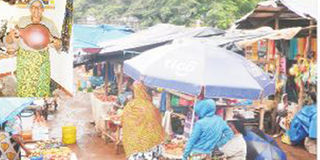TRAVEL : Authentic cultural tours for locals and tourists

The interactive local market at Kalali held every Monday and Thursday interest visitors in the area. Photo | Elisha Mayallah
What you need to know:
This was my experience recently, when I visited Nkweshoo, a locality in the sprawling Machame area found nearly a 20-minute drive from Moshi town, the administrative town of Kilimanjaro region. Nature is infinitely charming and engaging in the area; it puts time in another dimension. That is what I felt while interacting with the people, experiencing new taste, sights and sounds. The time I spent there was resourceful.
There is a sense of surprise once you visit a cultural heritage village in rural Tanzania. You might have an idea of what to expect when it comes to the food, language and various cultural practices of the people in that area. But then reality reveals an authentic delightful twist.
This was my experience recently, when I visited Nkweshoo, a locality in the sprawling Machame area found nearly a 20-minute drive from Moshi town, the administrative town of Kilimanjaro region. Nature is infinitely charming and engaging in the area; it puts time in another dimension. That is what I felt while interacting with the people, experiencing new taste, sights and sounds. The time I spent there was resourceful.
Nkweshoo is one of the traditional villages in Machame. It is a welcoming village of contrast with a lively, yet laid-back appeal. Its old-style yet simple buildings sit within coffee and banana farms. The silence and tranquillity in the village are punctuated only by crisp air that hung in the air almost throughout the day, including the call of birds chirping.
The beautiful panoramic landscape with great valleys, deep gorges, rivers, caves, natural forest and local agricultural activities on Arabica coffee farms is what makes Machame Nkweshoo a choice of many visitors, I noticed. The winding roads that traverse in the village entice visitors to take leisurely strolls to the rural background surrounded by rainforest. Gradually, over the millennia, these forests have been pushed back because of farming and an increasing population.
However, there are now reforestation programs in place which is coordinated by the cultural tourism programme. Tree planting and seed cultivation are being encouraged throughout the village, being part of the conservation project. Nkweshoo village has a rugged and placid infrastructure which offers a real thrill for those who want to discover the unknown. The local Kalali market is one of the tourists’ attractions that are still largely untouched by modernity and a rich tapestry of business people. It has been operating for decades.
History and the talk on nature dominated most of the briefing from Ms Stella Shoo, the cultural tourism coordinator in the area. She took me around to explore some of the remaining memorial stones. Some of these stones were put in place by Mr. Johannes Rebmann, a German missionary who came to Machame in the 1840s and built the first church in the area. It is believed that Rebmann was the first European to tell the world about Mt Kilimanjaro in 1848.
Ms Shoo explained how the early missionaries worked to expand the missionary work in other parts of Kilimanjaro region, in which they set up schools, hospitals and churches. She took me around to explore the whole route of the missionaries in the area and enjoy the scenery, people and see various old buildings.
The close geographical nearness and agricultural similarity linked with other Chagga clans from Marangu, Rombo, Uru and Kibosho has created a cultural assimilation with the Wamachame, most notably through intermarriage.
One of the highlights in the village is the Ntondolo cave which is nestled below the trig beacon in a rocky outcrop. Some of the rock faces are suitable for boulder climbing – the art of climbing without using rope as a backup, instead uses a crash pad or boulder mat to break falls. The Nkosalulu waterfall flowing from Mount Kilimanjaro forest with its water emptying into River Makoa is found nearly a half-an-hour walk from the Ntondolo cave.
The village has largely been hosting tourists since 2008, according to Ms Shoo. The image of a cultural village far from mass tourism has prevailed over the years. Mass tourism, in contrast, has no concern for the communities - seeking to make short-term profits by popularizing certain areas without any thought to the impact of tourism on indigenous peoples.
Fast facts:
Machame Nkweshoo cultural tourism enterprise was established in June 2008 with the vision of making a green village through tourism. People of Machame-Nkweshoo welcome visitors to explore cultural and Natural Heritage of the Wachagga ethnic group that live on the green slopes of Mount Kilimanjaro.
It offers a campsite with modern toilet facility, and a home stays within a beautiful garden full of flowers and clean water supply. Camping gears for hire at available.
There are many cultural activities organized here, which include visiting a traditional Chagga house; an opportunity to learn how to prepare local dishes, guided visit to Nkosalulu water falls; an opportunity to learn Chagga relics, stories and old tools that have been used since the ancient times and much more.
Email: [email protected]




